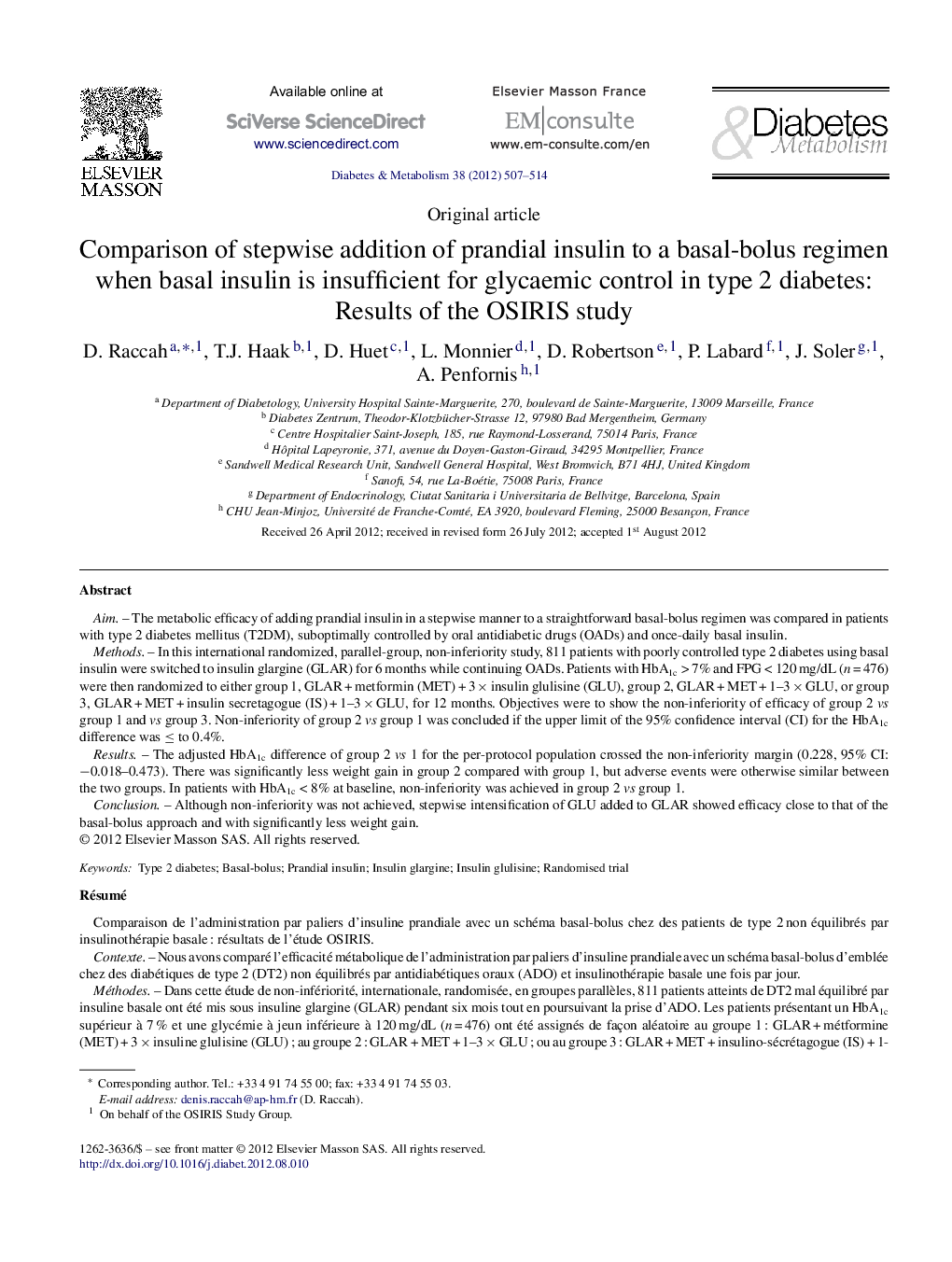| کد مقاله | کد نشریه | سال انتشار | مقاله انگلیسی | نسخه تمام متن |
|---|---|---|---|---|
| 3259935 | 1207597 | 2012 | 8 صفحه PDF | دانلود رایگان |

AimThe metabolic efficacy of adding prandial insulin in a stepwise manner to a straightforward basal-bolus regimen was compared in patients with type 2 diabetes mellitus (T2DM), suboptimally controlled by oral antidiabetic drugs (OADs) and once-daily basal insulin.MethodsIn this international randomized, parallel-group, non-inferiority study, 811 patients with poorly controlled type 2 diabetes using basal insulin were switched to insulin glargine (GLAR) for 6 months while continuing OADs. Patients with HbA1c > 7% and FPG < 120 mg/dL (n = 476) were then randomized to either group 1, GLAR + metformin (MET) + 3 × insulin glulisine (GLU), group 2, GLAR + MET + 1–3 × GLU, or group 3, GLAR + MET + insulin secretagogue (IS) + 1–3 × GLU, for 12 months. Objectives were to show the non-inferiority of efficacy of group 2 vs group 1 and vs group 3. Non-inferiority of group 2 vs group 1 was concluded if the upper limit of the 95% confidence interval (CI) for the HbA1c difference was ≤ to 0.4%.ResultsThe adjusted HbA1c difference of group 2 vs 1 for the per-protocol population crossed the non-inferiority margin (0.228, 95% CI: −0.018–0.473). There was significantly less weight gain in group 2 compared with group 1, but adverse events were otherwise similar between the two groups. In patients with HbA1c < 8% at baseline, non-inferiority was achieved in group 2 vs group 1.ConclusionAlthough non-inferiority was not achieved, stepwise intensification of GLU added to GLAR showed efficacy close to that of the basal-bolus approach and with significantly less weight gain.
RésuméContexteNous avons comparé l’efficacité métabolique de l’administration par paliers d’insuline prandiale avec un schéma basal-bolus d’emblée chez des diabétiques de type 2 (DT2) non équilibrés par antidiabétiques oraux (ADO) et insulinothérapie basale une fois par jour.MéthodesDans cette étude de non-infériorité, internationale, randomisée, en groupes parallèles, 811 patients atteints de DT2 mal équilibré par insuline basale ont été mis sous insuline glargine (GLAR) pendant six mois tout en poursuivant la prise d’ADO. Les patients présentant un HbA1c supérieur à 7 % et une glycémie à jeun inférieure à 120 mg/dL (n = 476) ont été assignés de façon aléatoire au groupe 1 : GLAR + métformine (MET) + 3 × insuline glulisine (GLU) ; au groupe 2 : GLAR + MET + 1–3 × GLU ; ou au groupe 3 : GLAR + MET + insulino-sécrétagogue (IS) + 1-3 × GLU pendant 12 mois. L’objectif était de démontrer la non-infériorité de l’efficacité du groupe 2 par rapport au groupe 1 et du groupe 2 par rapport au groupe 3. La non-infériorité du groupe 2 par rapport au groupe 1 était établie lorsque la limite supérieure de l’intervalle de confiance à 95 % (IC) de la différence d’HbA1c était inférieur ou égale à 0,4 %.RésultatsLa différence d’HbA1c corrigée du groupe 2 versus 1 pour la population per protocole a franchi la marge de non-infériorité (0,228 [IC à 95 %−0,018–0,473]). Le gain de poids dans le groupe 2 était significativement inférieure à celui du groupe 1. Les événements indésirables étaient semblables entre les groupes. Chez les patients présentant une HbA1c inférieure à 8 % à la randomisation, la non-infériorité était obtenue dans le groupe 2 versus groupe 1.ConclusionsBien que la non-infériorité n’ait pas été obtenue, l’intensification par paliers de GLU combinée à GLAR a montré une efficacité proche du schéma basal-bolus, avec un gain de poids significativement inférieur.
Journal: Diabetes & Metabolism - Volume 38, Issue 6, December 2012, Pages 507–514